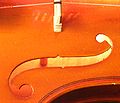Vibrato
Vibrato is a technique of the left hand and arm in which the pitch of a note varies in a pulsating rhythm. While various parts of the hand or arm may be involved in the motion, the end result is a movement of the fingertip bringing about a slight change in vibrating string length. Violinists oscillate backwards, or lower in pitch from the actual note when using vibrato, since perception favors the highest pitch in a varying sound. Vibrato does little, if anything, to disguise an out-of-tune note: in other words, vibrato is a poor substitute for good intonation. Still, scales and other exercises meant to work on intonation are typically played without vibrato to make the work easier and more effective. Music students are taught that unless otherwise marked in music, vibrato is assumed or even mandatory. This can be an obstacle to a classically-trained violinist wishing to play in a style that uses little or no vibrato at all, such as baroque music played in period style and many traditional fiddling styles.
Vibrato can be produced by a proper combination of finger, wrist and arm motions. One method, called "hand vibrato," involves rocking the hand back at the wrist to achieve oscillation, while another method, "arm vibrato," modulates the pitch by rocking at the elbow. A combination of these techniques allows a player to produce a large variety of tonal effects.
The "when" and "what for" of violin vibrato are artistic matters of style and taste. In acoustical terms, the interest that vibrato adds to the sound has to do with the way that the overtone mix (or tone color, or timbre) and the directional pattern of sound projection change with changes in pitch. By "pointing" the sound at different parts of the room in a rhythmic way, vibrato adds a "shimmer" or "liveliness" to the sound of a well-made violin




 After watching Lagaan, Iqbal and Chak De India, if you thought sports underdog drama is the recipe to set box office on fire, you’re wrong. No other movie could prove it better than Dhan Dhana Dhan Goal.
After watching Lagaan, Iqbal and Chak De India, if you thought sports underdog drama is the recipe to set box office on fire, you’re wrong. No other movie could prove it better than Dhan Dhana Dhan Goal.
